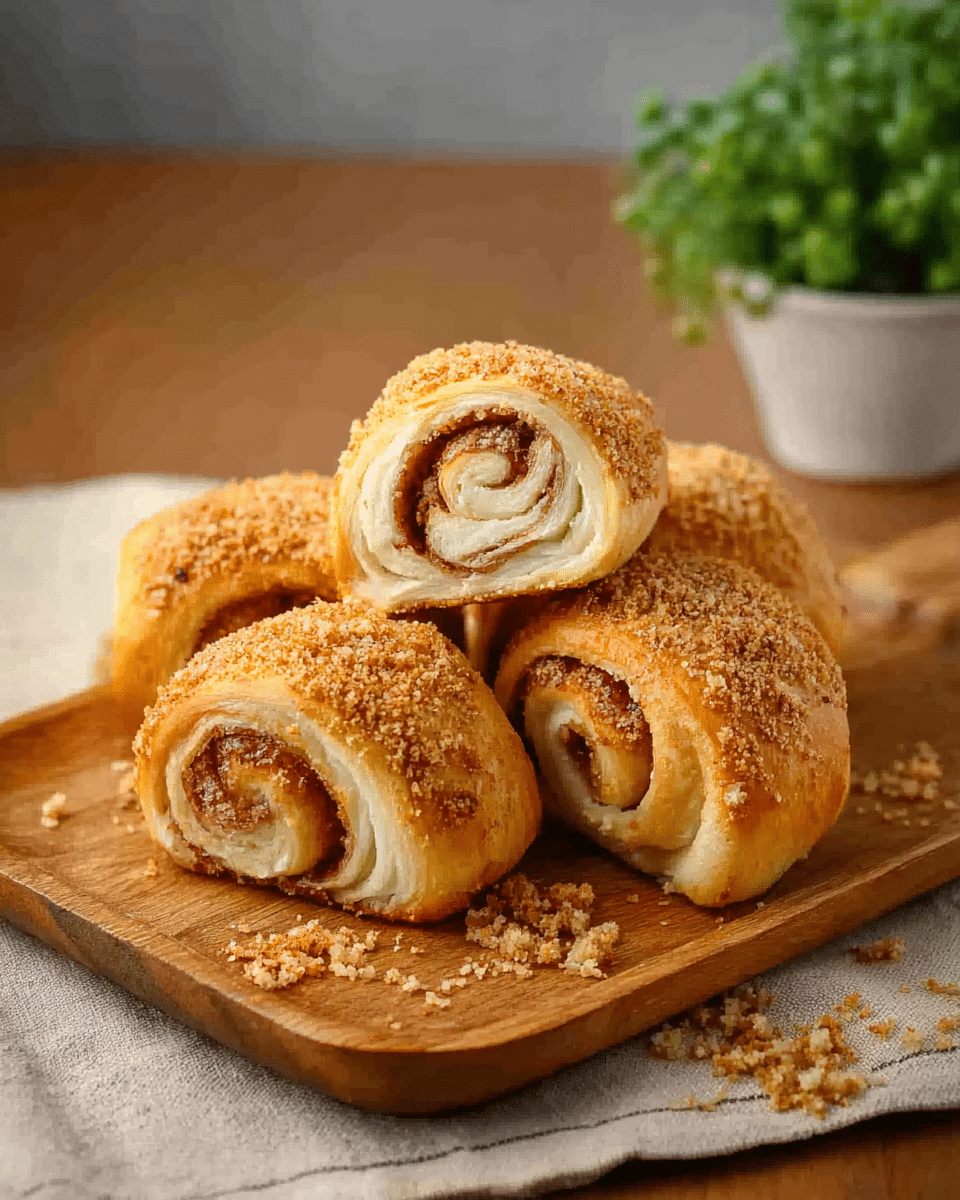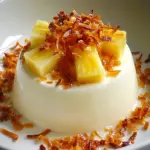Senorita Bread is a Filipino favorite—a soft and fluffy pastry roll with a sweet, buttery filling and a crunchy breadcrumb coating. Perfect for breakfast or as a snack, this bread is beloved for its balance of textures and nutty-like flavor (even though it contains no nuts). Popularized by Starbread Bakery in California, this treat is now a staple in many Filipino homes and can easily be recreated in your kitchen.
Full Recipe:
Ingredients
For the Dough:
-
1 cup warm milk (can substitute with almond or soy milk)
-
¼ cup sugar
-
3 cups all-purpose flour
-
2¼ tsp dry yeast
-
1 tsp salt
-
¼ cup melted butter
For the Buttery Filling:
-
¼ cup butter
-
½ cup brown sugar (or maple syrup)
-
3 tbsp milk
-
2 tsp all-purpose flour
-
½ cup breadcrumbs
For the Outer Coating:
-
¼ cup melted butter (for brushing)
-
½ cup breadcrumbs
Directions
Step 1 – Dough Preparation:
Warm the milk until it’s just warm—not hot—to avoid killing the yeast. Melt the butter and combine it with the milk and yeast.
In a large bowl, sift the flour and mix in the sugar and salt. Combine the dry ingredients with the milk mixture. Knead the dough (by hand or mixer) for about 5 minutes until it becomes elastic. Form a dough ball and let it rise in a greased bowl covered with a damp cloth for about 1 hour or until doubled in size.
Step 2 – Prepare the Filling:
While the dough is rising, melt the butter in a saucepan. Add brown sugar or maple syrup and stir until dissolved. Add milk and flour, and simmer until the mixture thickens. Stir in breadcrumbs and let the filling cool to thicken further.
Step 3 – Assembly and Baking:
Preheat oven to 180°C (356°F).
Punch down the dough and divide it into two equal parts. Roll each into a log and slice into 8 pieces (16 in total). Roll each piece into a ball and rest for 15 minutes.
Flatten each ball into a rectangle, add 1 teaspoon of filling in the center, and roll tightly, sealing the edge. Brush each roll with melted butter and coat in breadcrumbs.
Place on a parchment-lined baking tray and bake for 20 minutes, or until golden brown.
Nutrients (Per Roll — Approximate)
-
Calories: 231 kcal
-
Carbohydrates: 33g
-
Protein: 4g
-
Fat: 9g
-
Saturated Fat: 5g
-
Fiber: 1g
-
Sugar: 10g
Cultural Roots and Contemporary Rise
Señorita Bread’s origin is steeped in Filipino culinary heritage. Though its name might evoke Spanish influence—a result of over 300 years of colonial history—the bread has evolved into a uniquely local creation. While its roots are traditional, the bread gained massive popularity outside of the Philippines thanks in large part to Starbread Bakery in California. This family-run bakery rebranded the classic Spanish Bread as Señorita Bread and turned it into a cult favorite among Filipino-American communities.
As demand grew, so did the curiosity of those unfamiliar with Filipino cuisine. It’s now common to see Señorita Bread featured in multicultural food blogs, international bakeries, and home kitchens across the globe. The success of Starbread Bakery helped push this once humble pastry into the global spotlight, allowing it to transcend cultural borders while still maintaining its authentic identity.
The Allure of Texture and Taste
One of the biggest appeals of Señorita Bread is its complex layering of textures. When you bite into a freshly baked roll, you’re met with a crisp, lightly toasted exterior. This crunch is created by a simple breadcrumb coating, brushed with melted butter just before baking. Beneath that lies the heart of the experience: a soft, chewy dough that melts in the mouth and a sweet filling that’s rich, slightly nutty, and deeply satisfying.
Although the filling contains no actual nuts, the combination of butter, brown sugar, and breadcrumbs simulates a roasted, nutty flavor that appeals to a wide range of palates. The filling thickens as it cools, allowing it to stay perfectly nestled inside the roll even during baking. This makes every bite consistent in flavor and texture—a mark of careful preparation and a reason why the bread has developed such a loyal following.
Perfect for Any Occasion
Señorita Bread is remarkably versatile. While it shines brightest as a breakfast item or afternoon snack, it’s equally welcome at special occasions like birthdays, potlucks, or holiday celebrations. Its modest size makes it easy to serve in batches, and the recipe scales well for large gatherings. It’s also freezer-friendly; just bake, cool, and store in a sealed bag. Reheat for a few minutes in the oven and the bread regains much of its original texture and flavor.
Because the recipe is adaptable, it opens up room for customization. Some home bakers add cheese to the filling for a savory twist, while others mix in ube (purple yam) or coconut flakes for regional flair. Vegan versions are also possible by substituting dairy and butter with plant-based alternatives, without compromising taste or texture.
A Nostalgic Experience for the Diaspora
For many Filipinos living abroad, Señorita Bread represents more than just a pastry—it’s a symbol of home. The smell of freshly baked bread filled with sweet, buttery filling can evoke memories of childhood kitchens, neighborhood panaderias (bakeries), and quiet moments shared over coffee and conversation. This sense of nostalgia makes it especially meaningful for the diaspora, serving as both a comfort food and a cultural touchstone.
In Filipino communities worldwide, baking Señorita Bread has become a way of preserving cultural identity. Parents teach their children how to knead the dough and roll the filling, passing on not just a recipe but a tradition. The bread’s continued presence in both humble homes and trendy bakeries demonstrates its power to unite generations and bridge distances.
A Treat Made to Be Shared
Part of Señorita Bread’s magic lies in its shareability. Whether served warm to a table of guests or packed in boxes as gifts, these rolls foster a spirit of generosity and celebration. The act of making them is often communal—families gather to mix, knead, roll, and bake, turning an afternoon into a shared experience. The result is more than food; it’s a moment created, savored, and remembered.
With social media showcasing Filipino food more than ever, Señorita Bread has found a new life online as well. Videos of the dough rising, butter melting, and breadcrumbs toasting have captivated viewers around the world, turning the simple act of baking into a visual and emotional experience. It has helped attract younger generations who are curious to reconnect with their roots through food.
Conclusion: A Filipino Classic with Global Appeal
Señorita Bread is more than a sweet roll—it’s a cultural artifact, a comfort food, and a bridge between generations and geographies. It carries the warmth of Filipino hospitality and the richness of its culinary tradition, all wrapped up in a delicate, buttery pastry. Easy to make, delightful to eat, and impossible to forget, this bread has earned its place on the global stage, one golden-brown roll at a time.
Whether you’re an experienced baker or a curious food lover, Señorita Bread offers an invitation to discover the heart of Filipino home baking. It’s a recipe you’ll return to not just for the taste, but for the feeling it brings—of belonging, of warmth, and of home.






